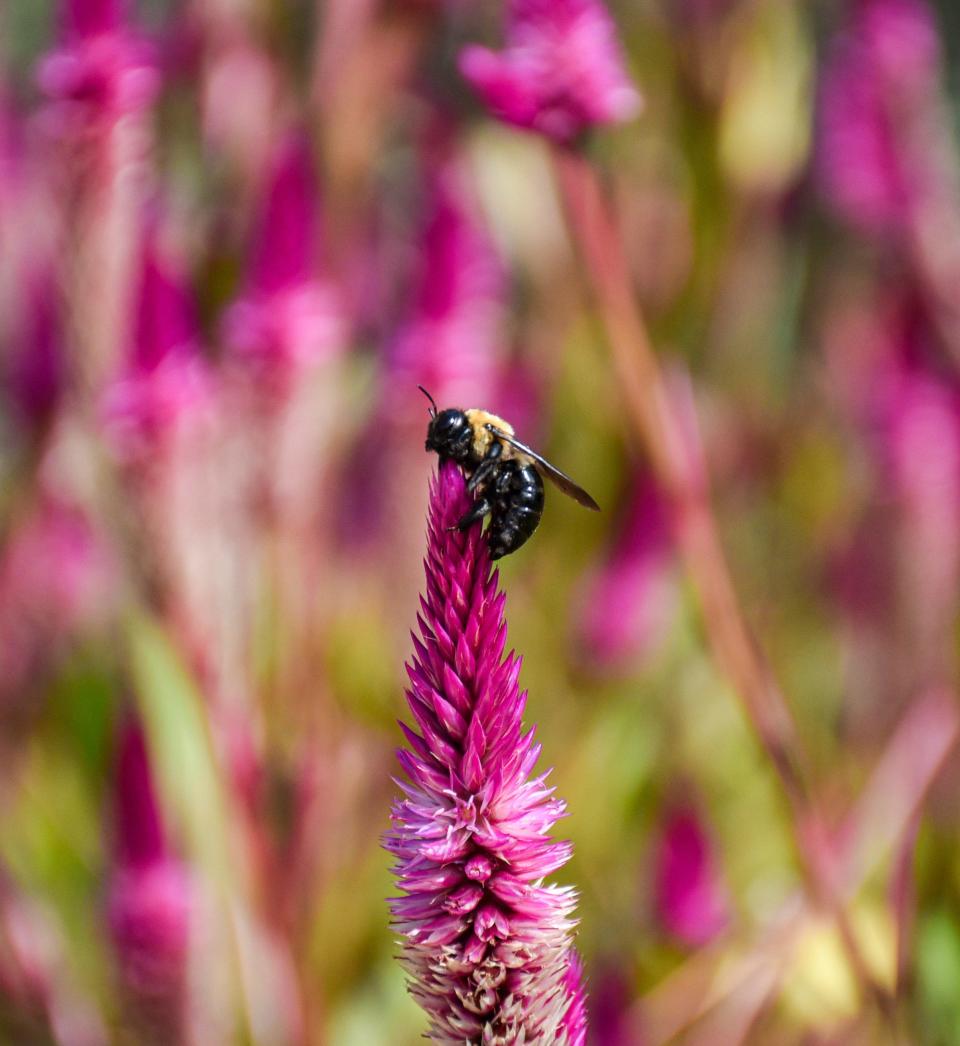Gardening Central Mass.: Supporting pollinators year-round

If you’re like me and so much of your life revolves around gardening, you tend to take note of what’s growing in other people’s flower beds. This summer, I noticed beebalm. Lots of it.
A relative of mint, beebalm (Monarda spp.) grows in tall, lush clumps with flowers that bloom in spiky crowns of pink, purple and red. Four species are native to New England, and with garden centers carrying cultivars like "Grape Gumball" and "Raspberry Wine," beebalm has become an easy-to-find, easy-to-grow summer bloom. But something else drives this perennial’s recent surge in popularity — pollinators love it.
Pollinators like bees, wasps, flies, butterflies and hummingbirds play an essential role in our ecosystems. While sipping nectar from flowers, these animals become dusted with grains of pollen that they transport to the next flower as they forage. Pollen from one flower is dropped onto the reproductive parts of another, and with this, our world keeps turning. One out of every three bites of food we eat is made possible by a pollinator.
Globally, pollinators face serious threats from habitat destruction, pesticide use and climate change. Though these problems feel vast, choosing to plant perennials like beebalm is one way to make a difference close to home. There are many other ways, too. The ideal pollinator garden offers more than summer blooms. It includes trees, shrubs, perennials and ground covers. Different types of plants grown in combination provide pollinators protection from predators and food sources from early spring through fall.
Not everyone has the capacity to build a three-season nectar buffet. Consider, instead, stewarding plants in public green spaces. Learning more about the region’s pollinators and their year-round needs helps, too, especially when you pass the knowledge on. Here are four seasonal tips to keep in mind.
Support Springs’ Early Risers
In Central Massachusetts, pollinators become active soon after the thaw. Some native bees emerging in early spring live short lifecycles, never venturing far from their nest sites. To feed their young, they rely on pollen and nectar nearby. Some bees even specialize in foraging from a single plant species.
Spring ephemerals, plants that grow quickly and flower briefly before trees fill out, support these pollinators. The mining bee, a native solitary bee, enjoys yellow trout lily (Erythronium americanum) and bloodroot (Sanguinaria canadensis). Trout lily spreads out nicely over time, and bloodroot adds a shock of bright white to an early spring garden.
When oak (Quercus spp.), black cherry (Prunus serotina) and maple (Acer spp.) trees start to bloom, food for adult pollinators becomes available on a grand scale. In urban and rural environments, planting trees and caring for established trees has enormous benefits. Lepidoptera (butterfly and moth) larvae rely on tree leaves for food, while canopy provides essential habitat for other insect pollinators and birds.
Provide Water and Nectar Resources During Summer
With nectar and pollen more plentiful in summer, charismatic pollinator species come out in force. Ruby throated hummingbirds and monarch butterflies fuel up at our gardens, meadows, fields and parks as part of long migrations. Beebalm (Monarda spp.), common milkweed (Asclepias syriaca), purple coneflowers (Echinacea purpurea) and sunflowers like Helianthus giganteus catch their eye.
For insect pollinators, water isn’t always as easy to come by as nectar, especially during drought years. Add a water source to your garden, patio or balcony. A small dish lined with pebbles and changed out often to avoid encouraging mosquitoes helps pollinators stay hydrated.
Extend the Bloom into Fall
Not all pollinators migrate. Queen American bumble bees stick around. While the rest of her colony perishes each autumn, she builds a nest and overwinters. Like a bear before hibernation, the queen bulks up by foraging for the season’s final drops of nectar. Plant and protect native favorites like golden rod (Solidago spp.) and New England aster (Symphiotrichum novae-angliae) that bloom late into fall.
Protect Winter Habitat
Our garden plants may be dormant in winter, but native bees still have needs. Overwintering pollinators require nesting sites. They hunker down in brush piles, logs, leaves, and dried plant stems. To support them, clean up less. Leaving some yard debris through fall and winter enables the return of pollinators and other beneficial insects in spring.
Gardening Central Mass. is written by the team at New England Botanic Garden at Tower Hill. Located on 171 acres in Boylston, New England Botanic Garden is one of the region’s top horticultural resources. All year long, garden visitors experience the wonder of plants, learn about the natural world, and make joyful connections. There is so much growing at the garden. Discover it today at www.nebg.org. The column will be published on the third Sunday of the month.
This article originally appeared on Telegram & Gazette: Gardening Central Mass.: Tips for supporting pollinators year-round

 generic
generic 